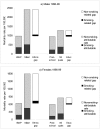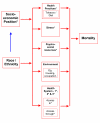What potential has tobacco control for reducing health inequalities? The New Zealand situation
- PMID: 17081299
- PMCID: PMC1654162
- DOI: 10.1186/1475-9276-5-14
What potential has tobacco control for reducing health inequalities? The New Zealand situation
Abstract
In this Commentary, we aim to synthesize recent epidemiological data on tobacco and health inequalities for New Zealand and present it in new ways. We also aim to describe both existing and potential tobacco control responses for addressing these inequalities. In New Zealand smoking prevalence is higher amongst Māori and Pacific peoples (compared to those of "New Zealand European" ethnicity) and amongst those with low socioeconomic position (SEP). Consequently the smoking-related mortality burden is higher among these populations. Regarding the gap in mortality between low and high socioeconomic groups, 21% and 11% of this gap for men and women was estimated to be due to smoking in 1996-99. Regarding the gap in mortality between Māori and non-Māori/non-Pacific, 5% and 8% of this gap for men and women was estimated to be due to smoking. The estimates from both these studies are probably moderate underestimates due to misclassification bias of smoking status. Despite the modest relative contribution of smoking to these gaps, the absolute number of smoking-attributable deaths is sizable and amenable to policy and health sector responses. There is some evidence, from New Zealand and elsewhere, for interventions that reduce smoking by low-income populations and indigenous peoples. These include tobacco taxation, thematically appropriate mass media campaigns, and appropriate smoking cessation support services. But there are as yet untried interventions with major potential. A key one is for a tighter regulatory framework that could rapidly shift the nicotine market towards pharmaceutical-grade nicotine (or smokeless tobacco products) and away from smoked tobacco.
Figures



References
-
- Howden-Chapman P, Tobias MI. Social inequalities in health: New Zealand 1999. Wellington, Ministry of Health; 2000.
-
- Blakely T, Fawcett J, Atkinson J, Tobias M, Cheung J. Decades of Disparity II: Socioeconomic mortality trends in New Zealand 1981-1999. Wellington, Ministry of Health; 2005.
-
- Fawcett J, Blakely T, Robson B, Tobias M, Pakipaki N, Harris R. Decades of Disparity III: Overlapping Ethnic and Socioeconomic Mortality Inequalities in New Zealand, 1981-1999. Wellington, Ministry of Health; 2006.
LinkOut - more resources
Full Text Sources
Miscellaneous

